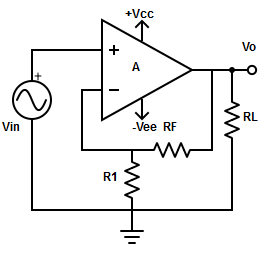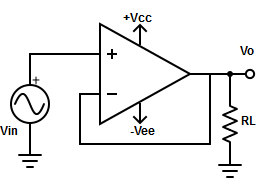This set of Linear Integrated Circuit online quiz focuses on “Voltage Series Feedback Amplifier – 2”.
1. Find the input and output resistance for the circuit shown.
Specification for 741 op-amp : A=400000 ; Ri = 33MΩ; Ro = 60Ω;
RF = 11kΩ; R1 = 2kΩ; Supply voltage = ± 15v; Maximum output voltage swing = ± 13v.

a) RIF = 66MΩ, ROF = 30Ω
b) RIF = 30MΩ, ROF = 6kΩ
c) RIF = 15kΩ, ROF = 50MΩ
d) None of the mentioned
View Answer
Explanation: AF = 1+(RF/R1) = 1+(11kΩ/2kΩ) = 6.5;
B= 1/ AF = 1/6.5 = 0.154;
Input resistance of RIF = R1(1+AB) = 33MΩ[1+(6.5*0.154) ]= 66MΩ;
Output resistance of ROF = Ro/(1+AB) = 60/[1+(6.5*0.154) ]= 29.98 ≅30Ω.
2. The output resistance of the op-amp with feedback is
a) Same as that of the output resistance without feedback
b) Greater than that of the output resistance without feedback
c) Smaller than that of the output resistance without feedback
d) None of the mentioned
View Answer
Explanation: In voltage series feedback amplifier, the output resistance is (1/(1+AB)) times the output resistance of the op-amp. Therefore, the output resistance of the op-amp with feedback is much smaller than the output resistance without feedback.
3. Find the output current in the voltage series feedback amplifier.
a) io ={ [Vo+(A*Vid)]/Ro}
b) io ={ [Vo-(A*Vid)]/Ro}
c) io =(Vo/Ro)*A
d) io =[A*(Vo-Vid)]/Ro
View Answer
Explanation: The output current in voltage series feedback amplifier is given as io ={[Vo-(A*Vid)]/Ro}.
4. Find the unity gain bandwidth for voltage series feedback amplifier?
a) UBG = Afo
b) UBG = AfF
c) UBG = Afo fF
d) UBG = AFfo
View Answer
Explanation: The unity gain bandwidth is given as product of open loop voltage gain and break frequency of an op-amp.
5. The bandwidth of a non-inverting amplifier with feedback is equal to
a) fo(AB)
b) fo(AB-1)
c) fo(1+AB)
d) fo(1-AB)
View Answer
Explanation: The bandwidth of the non-inverting amplifier with feedback is equal to its bandwidth without feedback times (1+AB). i.e. fF=fo(1+AB).
6. How are the saturation voltage specified on the manufacture’s datasheet?
a) Negative voltage
b) Output voltage swing
c) Supply voltage
d) None of the mentioned
View Answer
Explanation: In an open loop op-amp, the total output offset voltage (i.e. output voltage swing) is equal to either the positive or negative saturation voltage.
7. What is the formula for total output offset voltage with feedback?
a) VooT = ± Vo/(1+AB)
b) VooT = ± Vsat*(1+AB)
c) VooT = ± Vsat/(1+AB)
d) VooT = ± Vo*(1+AB)
View Answer
Explanation: The total output offset voltage with feedback = (Total output offset voltage witput feedback) / (1+AB). i.e. VooT = ± Vsat/(1+AB).
8. Which of the following has the same characteristic as that of non-inverting amplifier with feedback?
a) Perfect feedback amplifier
b) Voltage follower
c) Perfect voltage amplifier
d) All of the mentioned
View Answer
Explanation: A perfect voltage amplifier has very high input resistance, very low output resistance, stable voltage gain, large bandwidth and very little output offset voltage.
From the analysis of the characteristic of non-inverting amplifier with feedback, it is clear that it exhibits the characteristics of a perfect voltage amplifier.
9. What is the gain of voltage follower?
a) Gain > ∞
b) Gain –>1
c) Gain <1
d) Gain –>∞
View Answer
Explanation: Voltage follower is non-inverting amplifier configured for unity gain. Such that the output voltage is equal to and in phase with the input.
10. Which is preferred to attain higher input resistance and the output amplitude equal to input?
a) Voltage follower
b) Voltage series feedback amplifier
c) Voltage shunt feedback amplifier
d) Inverter
View Answer
Explanation: In the voltage follower the output follow the input due to unity gain. Therefore, it is attained to get higher input resistance and output amplitude equal to input.
11. Find the input and output voltage in voltage follower circuit?
a) Vin=2v and Vout = 3v
b) Vin=10v and Vout = 11v
c) Vin=9v and Vout = 9v
d) Vin=4v and Vout = 7v
View Answer
Explanation: Voltage follower has input voltage equal to output voltage. The closed loop voltage gain is equal to one. For example, take the input and output voltage to be 2v, then AF = Vout/Vin = 2v/2v = 1.
12. Voltage follower is also called as
a) None of the mentioned
b) Non-inverting amplifier
c) Inverting amplifier
d) Normal buffer
View Answer
Explanation: The voltage follower is also called as a non-inverting buffer because, when placed between two networks, it removes the loading on the first network.
13. Find the bandwidth and total output offset voltage of a voltage follower? The following are the specifications for the op-amp 741: A=200000, fo =5hz and supply voltage =±15v.

a) fF = 1000hz, VooT = ± 7.5µv.
b) fF = 100khz, VooT = ± 7.5µv.
c) fF = 10khz, VooT = ±7.5µv.
d) fF = 1000khz, VooT = ± 7.5µv.
View Answer
Explanation: Bandwidth fF =A* fF = 200000*5= 1Mhz.
Total output offset voltage, VooT= ±Vsat/A= ±15/200000 =± 7.5µv.
Sanfoundry Global Education & Learning Series – Linear Integrated Circuits.
To practice all areas of Linear Integrated Circuit for online Quizzes, here is complete set of 1000+ Multiple Choice Questions and Answers.
If you find a mistake in question / option / answer, kindly take a screenshot and email to [email protected]
